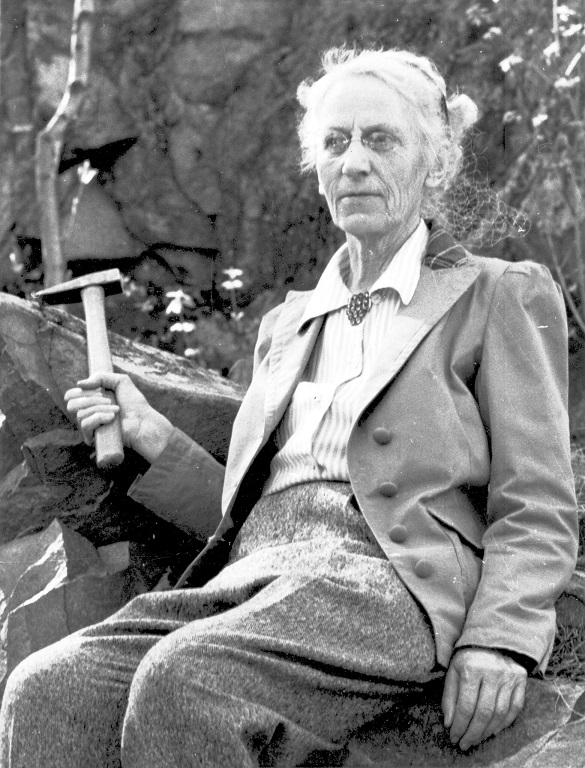Summary | Excerpt | Reviews | Beyond the Book | Read-Alikes | Genres & Themes | Author Bio

A Novel
by Caoilinn HughesThis article relates to The Alternatives
 In Caoilinn Hughes' The Alternatives, Olwen is a geologist profoundly concerned with the effects of climate change. As in other sciences, women remain underrepresented in geology, even though they have been very much part of its development over the centuries.
In Caoilinn Hughes' The Alternatives, Olwen is a geologist profoundly concerned with the effects of climate change. As in other sciences, women remain underrepresented in geology, even though they have been very much part of its development over the centuries.
St. Hildegard of Bingen (1098-1179) was a scholar of precious stones, to which she referred in her theological and scientific writings. Martine de Bertereau (1600-1642) traveled with her husband to survey mines, used divining rods to locate minerals and water deposits, and was arrested on suspicion of witchcraft, tragically dying in prison. Nevertheless, women geologists persisted, and the 19th century saw an increase in female scientists for whom this area of study became a passion.
One of the earliest was Etheldred Benett (1775-1845), considered the first female geologist in Britain. Her independent wealth enabled her to study and collect fossils, on which she became a noted expert and published several books. The travel writer Maria Graham (1785-1842) was the first woman to publish a paper in the journal of the Geological Society of London, on the series of earthquakes she experienced in Chile in 1822. Charlotte Murchison (1788-1869) and Mary Buckland (1797-1857) were geologists and fossil collectors who created illustrations of geological features (i.e., cliffs and valleys) and fossils, respectively.
Scottish geologist Maria Gordon (1864-1939) was the first woman awarded a Doctor of Science degree in geology, the first woman to earn a PhD from the University of Munich, and the winner of the Geological Society's Lyell Medal in 1932. She studied the Dolomites, demonstrating that limestone peaks of the region were formed by tectonic plate movements. Gertrude Elles (1872-1960) was an expert on graptolites and the first woman awarded the Geological Society's Murchison Medal (in 1919), and its first woman Council member. When she was awarded the Lyell Fund in 1900, women could not attend the Society's meetings, so she was unable to collect the award herself, but had to send a male colleague.
In the US, in 1896, Florence Bascom (1862-1945) was the first woman to earn a PhD from Johns Hopkins University, the first female geologist to work for the United States Geological Survey, and, in 1924, the first woman elected to the Council of the Geological Society of America. Alice Wilson (1881-1964) was Canada's first woman geologist, specializing in rocks and fossils of the Ottawa region. In 1909, she was the first woman to work for the Geological Survey of Canada and, in 1938, the first female Fellow of the Royal Society of Canada.
The 20th century saw more women coming to the fore as geologists. Marguerite Thomas Williams (1895-1991) became the first African American to earn a doctorate in geology in the US, from the Catholic University of America in 1942. Williams was an expert in the effects of human activity and landscaping on erosion and flooding. In 1936, Danish scientist Inge Lehmann (1888-1993) discovered the solid inner core of the Earth, while American geologists Alice Mary Weeks (1909-1988) and Mary E. Thompson were the first to identify uranophane in 1953.
Women geologists continue to expand horizons in the field. Claudia Alexander (1959-2015) specialized in geophysics and planetary science, working for the United States Geological Survey, NASA's Jet Propulsion Laboratory, and as project manager of NASA's Galileo mission to Jupiter. Other women leaders include Doris Malkin Curtis (1914-1991), who became the first woman president of the Geological Society of America in 1990; and Marcia McNutt (born 1952), who became the first female director of the United States Geological Survey in 2009 and the first woman president of the US National Academy of Sciences in 2016.
Despite the accomplishments and breakthroughs of women in geology, they still only account for one third of geoscientists in the United States and are only 27% of geoscience faculty at universities. However, the number of women earning PhDs in the geosciences reached 45% in 2016 and has seen a steady increase since. Systemic sexism and barriers remain, but, as more women follow in the footsteps of the female trailblazers of history, and as geology and geoscience become ever more important in the context of climate change, there is hope for parity and equality in the future.
Canadian geologist Alice Wilson, courtesy of Women in Mining Canada
Filed under Medicine, Science and Tech
![]() This "beyond the book article" relates to The Alternatives. It originally ran in May 2024 and has been updated for the
April 2025 paperback edition.
Go to magazine.
This "beyond the book article" relates to The Alternatives. It originally ran in May 2024 and has been updated for the
April 2025 paperback edition.
Go to magazine.
Your guide toexceptional books
BookBrowse seeks out and recommends the best in contemporary fiction and nonfiction—books that not only engage and entertain but also deepen our understanding of ourselves and the world around us.